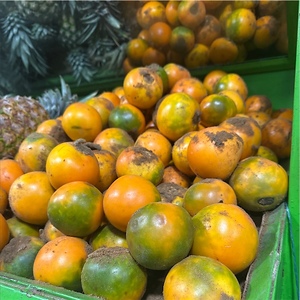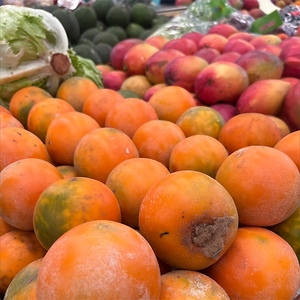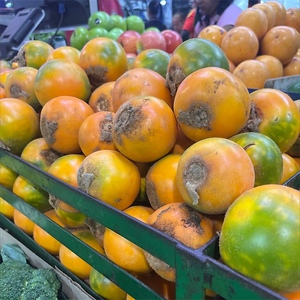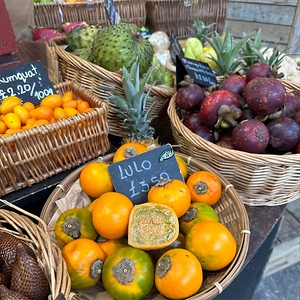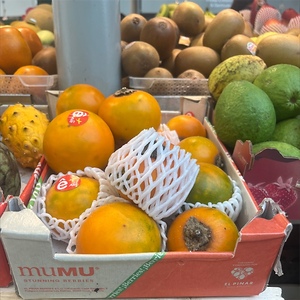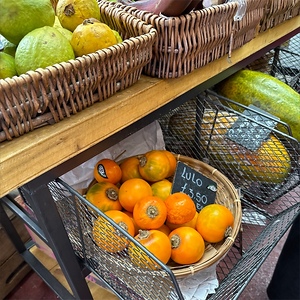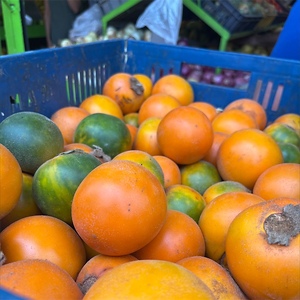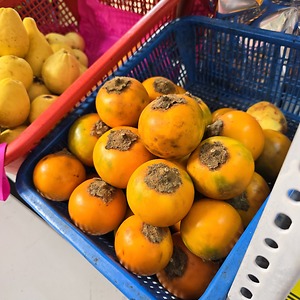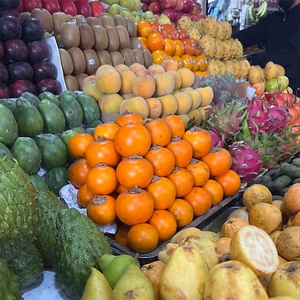

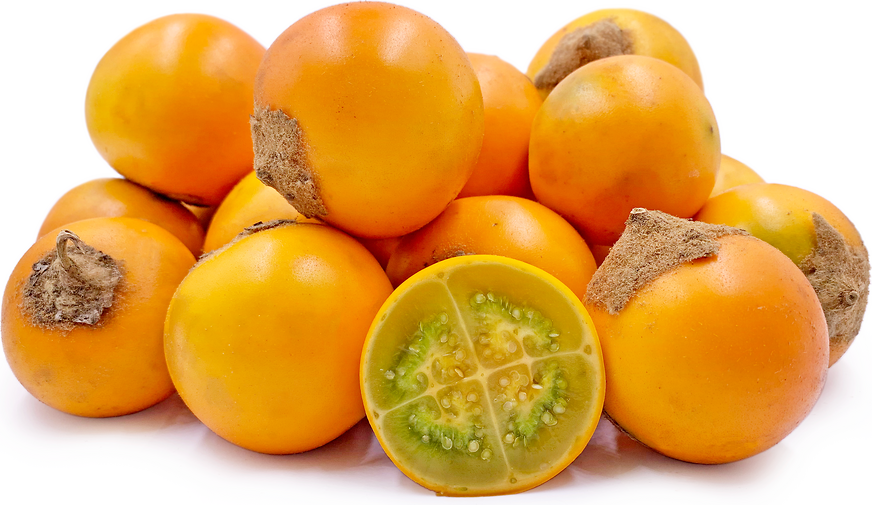
Lulo
Estimated Inventory, lb : 0
Description/Taste
Lulo fruits are small in size, averaging 4 to 6 centimeters in diameter and 40 to 120 grams in weight, and have a round to ovate shape with a curved, uniform nature. The fruits are capped with a five-pointed, rough, brown calyx, and the skin is thick, ranging from 3 to 4 millimeters in depth. The skin is also leathery, tough, and inedible, either smooth or covered in brittle hairs. These hairs are typically brown and can be removed from the skin, but care should be taken to wear gloves as these hairs may irritate sensitive skin. Lulo fruits ripen from green to a bright orange-yellow, and the skin is easily bruised or damaged. Underneath the surface, a pale orange membrane encases four chambers with a gelatinous, aqueous, jelly-like pulp. The pulp is filled with translucent yellow-green juice and small, flat, pale-yellow seeds, giving the mixture a slippery, slightly crunchy consistency. Lulo fruits are only consumed ripe, and mature fruits have a soft give when gently squeezed. The fruits will also have a bright golden orange hue and should be even in color with an aromatic quality. Ripe Lulo fruits have a sweet, acidic, and sour taste with tangy and refreshing tropical kiwi, lime, and citrus notes. The fruits also have a subtly rhubarb-like nuance, and the flavor will vary depending on the region and climate the fruit is grown in. When cooked, Lulo fruits develop a mellower, sweet, and less tangy taste.
Seasons/Availability
Lulo fruits are available year-round in some tropical climates. The fruits generally have a peak season in the dry or summer season in the Southern Hemisphere, which spans between December and March.
Current Facts
Lulo, botanically classified as Solanum quitoense, is a tropical species belonging to the Solanaceae or nightshade family. The small fruits grow on herbaceous, perennial shrubs reaching 1 to 3 meters in height and develop along the plant's thick stems in clusters of 3 to 4 fruits. Each plant can produce approximately 100 to 150 fruits per year, and there are two main types, a spineless fruit, and a hairy, soft-spined fruit. Lulo fruits are further divided in some counties by other descriptors, but in general, the fruits are harvested throughout Central and South America for culinary and medicinal practices. Lulo fruits are only consumed ripe and are a favored ingredient for juices. Despite their popularity as a beverage, Lulo fruits are delicate and easily damaged when handled, preventing the species from being commercially grown on a large scale. Lulo fruits are also known as Naranjilla, translating to "little orange," and are called this name in Colombia. The fruits are also known as Naranjita de Quito in Ecuador and Peru, Nuqui, Lulun, and Toronjaludo in other Spanish-speaking countries. Lulo fruits are nicknamed the "Nectar of the Gods" and the "Golden Fruit of the Andes" and are revered for their tart and tangy juice. In the modern day, Lulo fruits are typically cultivated and sold fresh in local markets surrounding their growing region, and the fruits are versatile, both used in sweet and savory preparations.
Nutritional Value
Lulo fruits are a source of fiber to regulate the digestive tract, vitamin A to maintain healthy organ functioning, and vitamin C to strengthen the immune system. The fruits also provide calcium to build strong bones and teeth, phosphorus to repair tissues, iron to develop the protein hemoglobin for oxygen transport through the bloodstream, and other nutrients, including zinc, magnesium, thiamine, niacin, vitamin K, and riboflavin. In Colombia, Lulo fruits are believed to detox the body, promote digestion, and improve skin complexion. The fruits also contain ellagitannins, compounds converted into ellagic acid, which have antioxidant properties to protect the cells against the damage caused by free radicals.
Applications
Lulo has a sweet and sour, tropical, tangy taste suited for fresh and cooked preparations. It is important to note that only the juicy pulp and seeds are edible, and the membranes and the thick skin should be discarded. The fruits can be sliced in half, and the flesh scooped with a spoon, or the pulp and seeds can be squeezed from the skin directly into the mouth. Lulo fruits are sometimes salted or sprinkled with sugar for enhanced flavoring or used as a fresh topping over yogurt and fruit salads. In Ecuador, Lulo is popularly used to make sorbets, sherbets, ice cream, and popsicles. The pulp can also be incorporated as a filling for baked goods, pudding, and pastries or drizzled over cakes, pies, and cheesecakes. In addition to fresh preparations, Lulo can be simmered into jams, jellies, syrups, and hot sauces or added to savory soups and stews. In Colombia, Lulo fruits are primarily added to juices, smoothies, wines, and cocktails. Lulada is a traditional beverage comprised of Lulo, sugar, and water and is the most famous Lulo-infused beverage. Other drinks include champus, a beverage of corn, pineapple, and Lulo. Lulo pairs well with other fruits such as oranges, limes, pineapples, and bananas, herbs such as cilantro and mint, meats including pork and chicken, brown sugar, condensed milk, and spices such as cloves and cinnamon. Unripe Lulos can be stored at room temperature for 3 to 8 days or in the refrigerator for up to one month. Once ripe, the fruits should be immediately consumed for the best quality and flavor and will keep for 7 to 10 days when stored in a perforated plastic bag in the fridge. Lulo fruits can also be frozen for up to one year.
Ethnic/Cultural Info
Lulo was featured at New York's World Fair in 1939. The fair was held in Flushing Meadows-Corona Park in Queens, New York, and it took over four years to plan for the event. The fair was initially designed in 1935 to lift spirits and bring New York City out of the Great Depression, and when it opened in 1939, the event's theme was "The World of Tomorrow." The fair also opened on April 30th, commemorating the 150th anniversary of George Washington's inauguration as President, another celebration that occurred in New York. The World Fair highlighted unique foods grown worldwide, and Lulo was selected in hopes of adding the fruits as a new cultivated item in the United States. During the fair, Lulo fruits were displayed at an exhibit, and over 1,500 gallons of juice were made from the fruits for sampling. Lulo juice was enthusiastically met with interest from fair attendees, and seeds of the species were later distributed to growers by the United States Department of Agriculture. Despite the generated interest, Lulo fruits were not successfully cultivated in the United States due to unsuitable growing conditions. A small population was effectively planted in Florida in the 1940s but was later destroyed during a hurricane.
Geography/History
Lulo fruits are native to tropical, low elevations of the Andes mountains of western South America, specifically in Ecuador, Colombia, and parts of Peru. Much of the species' history is unknown, but some experts believe the fruits were consumed during the Inca Empire and were known as Lulum. Lulo fruits were first recorded in written documents in the mid-17th century and were later introduced into Central America, where they are primarily grown in Panama, Guatemala, and Costa Rica. Lulo fruits were also carried to Southeast Asia and were planted on a small scale in the Philippines and Indonesia. In 1913, Lulo seeds were given from Colombia to the United States Department of Agriculture, and in 1914, seeds were imported from Ecuador and planted in Florida. Today Lulo fruits are primarily grown in Ecuador, Colombia, and select regions of Central and South America. In Colombia, the species is cultivated in the departments of Valle del Cauca, Cundinamarca, Tolima, Antioquia, Meta, and Boyaca. In Ecuador, the Yunguillas and Pastaza Valleys are the main production regions. The fruits are rare to find fresh outside Central and South America, but small populations exist in the United States, Australia, Mexico, and Southeast Asia. The fruits are also processed into concentrates or canned in syrup and are shipped frozen to retailers worldwide.
Recipe Ideas
Recipes that include Lulo. One







